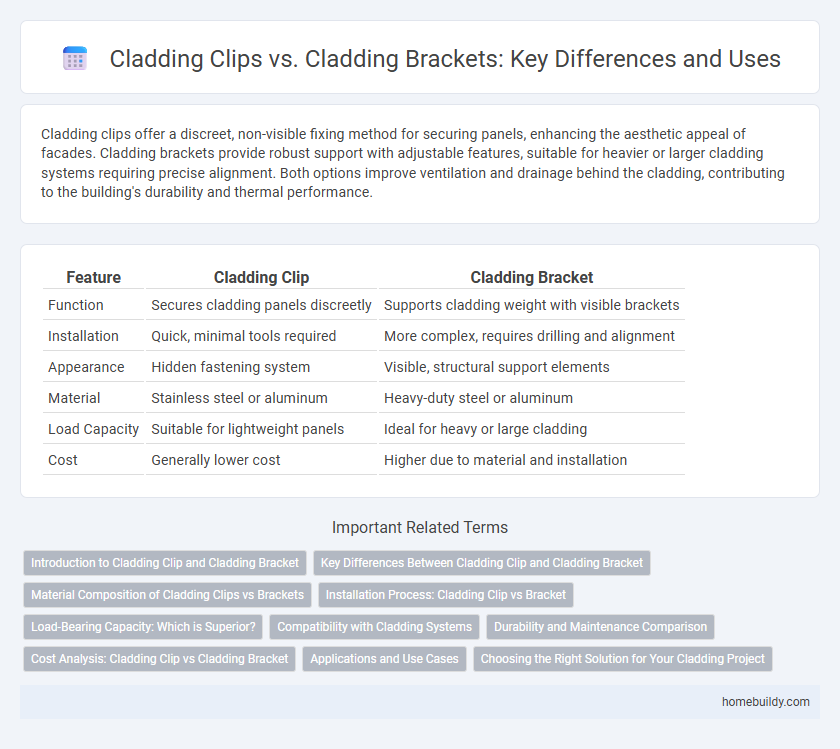Cladding clips offer a discreet, non-visible fixing method for securing panels, enhancing the aesthetic appeal of facades. Cladding brackets provide robust support with adjustable features, suitable for heavier or larger cladding systems requiring precise alignment. Both options improve ventilation and drainage behind the cladding, contributing to the building's durability and thermal performance.
Table of Comparison
| Feature | Cladding Clip | Cladding Bracket |
|---|---|---|
| Function | Secures cladding panels discreetly | Supports cladding weight with visible brackets |
| Installation | Quick, minimal tools required | More complex, requires drilling and alignment |
| Appearance | Hidden fastening system | Visible, structural support elements |
| Material | Stainless steel or aluminum | Heavy-duty steel or aluminum |
| Load Capacity | Suitable for lightweight panels | Ideal for heavy or large cladding |
| Cost | Generally lower cost | Higher due to material and installation |
Introduction to Cladding Clip and Cladding Bracket
Cladding clips are fastening components designed to securely attach cladding panels to building structures, offering a concealed fixing method that enhances aesthetic appeal and allows for panel movement due to thermal expansion. Cladding brackets, in contrast, serve as structural supports mounted to the building frame, providing a robust base for cladding systems and accommodating heavier loads or complex facade designs. Both cladding clips and brackets are essential in modern architectural envelopes, with clips prioritizing discrete attachment and brackets emphasizing structural stability.
Key Differences Between Cladding Clip and Cladding Bracket
Cladding clips provide a concealed fixing solution that ensures a sleek facade by firmly securing panels without visible fasteners, while cladding brackets offer a more robust support system capable of handling heavier loads and greater structural movement. Clips are typically used for lightweight materials and facilitate easier alignment, whereas brackets are chosen for larger, heavier cladding systems requiring enhanced durability. The primary difference lies in the balance between aesthetic appeal and structural strength tailored to specific facade requirements.
Material Composition of Cladding Clips vs Brackets
Cladding clips are typically manufactured from stainless steel or high-strength aluminum alloys, providing excellent corrosion resistance and durability in harsh environments. In contrast, cladding brackets often use galvanized steel or thicker metal components to ensure structural support and load-bearing capacity. The choice of material composition directly impacts the longevity, flexibility, and installation ease of the cladding system.
Installation Process: Cladding Clip vs Bracket
Cladding clips offer a quicker and more precise installation process compared to cladding brackets, as they are designed for simple snap-on attachment without the need for additional fasteners or pre-drilled holes. Cladding brackets typically require complex alignment, drilling, and bolting, which can increase labor time and installation errors. The reduced installation complexity with cladding clips results in lower labor costs and faster project completion for facade panel systems.
Load-Bearing Capacity: Which is Superior?
Cladding clips generally offer moderate load-bearing capacity suited for lightweight panels, while cladding brackets provide superior strength and support for heavier facade systems. The robust design of cladding brackets allows them to bear substantial vertical and lateral loads, making them ideal for larger, heavier cladding materials. Engineers often prefer cladding brackets in high-stress applications due to their enhanced structural stability and load distribution capabilities.
Compatibility with Cladding Systems
Cladding clips offer precise compatibility with various panel materials, ensuring secure attachment without damaging the surface, which makes them ideal for lightweight and flexible cladding systems. Cladding brackets provide a robust support structure suited for heavier cladding materials like stone or metal panels, facilitating load distribution and alignment. Selecting between clips and brackets depends on the specific cladding system's weight, material type, and design requirements to optimize performance and durability.
Durability and Maintenance Comparison
Cladding clips offer superior durability due to their corrosion-resistant materials such as stainless steel and aluminum, reducing the risk of structural failure over time compared to cladding brackets, which are often made from less resilient metals. Maintenance requirements for cladding clips are minimal since their fixed design reduces movement and wear, whereas cladding brackets may require frequent inspections and tightening due to potential loosening from thermal expansion. Choosing cladding clips can lead to lower long-term maintenance costs and increased structural integrity in building envelope applications.
Cost Analysis: Cladding Clip vs Cladding Bracket
Cladding clips generally offer a more cost-effective solution compared to cladding brackets due to lower material and installation expenses, making them ideal for budget-sensitive projects. Cladding brackets, while often more durable and capable of supporting heavier loads, typically incur higher upfront costs and require more labor-intensive installation processes. Evaluating lifecycle costs, cladding clips tend to reduce overall expenditure, but cladding brackets may provide better value in applications demanding superior structural support and longevity.
Applications and Use Cases
Cladding clips are ideal for lightweight facade systems where quick installation and minimal structural impact are required, commonly used in ventilated facades and curtain wall systems. Cladding brackets provide robust support for heavier cladding materials like stone or large panels, offering enhanced load-bearing capacity in commercial and industrial building applications. Choosing between clips and brackets depends on material weight, facade design, and installation speed requirements.
Choosing the Right Solution for Your Cladding Project
Cladding clips offer a streamlined installation process and enhanced durability by providing secure fastening without penetrating the cladding material, reducing the risk of water ingress. Cladding brackets, however, excel in supporting heavier cladding panels and allow for adjustable spacing, making them ideal for complex or large-scale projects. Selecting between cladding clips and brackets depends on factors such as cladding material weight, wall structure, and desired installation speed to ensure optimal performance and longevity.
Cladding clip vs Cladding bracket Infographic

 homebuildy.com
homebuildy.com